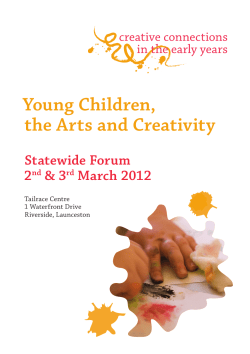
Social Media and Recordkeeping Allegra Huxtable Manager Government Recordkeeping
Social Media and Recordkeeping Allegra Huxtable Manager Government Recordkeeping Tasmanian Archive and Heritage Office Overview •What is Social media •Social Media as a record •How to capture social media records •Legal risks •Privacy •Copyright •Records Management Policy What is Social Media? Social media or Web 2.0 is any web-based environment that allows users to easily create, publish and share content. The User is able to control the data, to create modify, discuss an share internet content. Its user centred interactive information sharing design and collaboration. Current Examples Social Media – Web 2.0 applications Social media with servers hosted by external organisations: • social networking sites including Facebook, LinkedIn, MySpace, Google+, or Yammer • video and photo sharing websites including Flickr, Tumblr, Instagram, or YouTube • corporate and personal blogs • blogs hosted by media outlets - ‘have your say‘ feature on themercury.com.au • micro-blogging including Twitter • wikis and online collaborations including Wikipedia • forums, discussion boards and groups including Google groups, or Whirlpool Current Examples - Social Media – Web 2.0 applications •vod and podcasting •online multiplayer gaming platforms including World of Warcraft, or Second life •instant messaging, including SMS •geo-spatial tagging including Foursquare, Google maps, or Pinterest Why are we using social Media? Provides opportunities to: •deliver services •Consult •Communicate Social Media is: •Cost –effective •Instantaneous •responsive Does using social medial result in a state record? Yes!! When used to conduct government business!! Private Use is not a state records Responses created by agency staff, as a part of there work, such as a comment on a blog post or a reply to a tweet, are state records Monitoring Social Media If a Tasmanian government action is initiated from this monitoring then this social media content should be captured as a state record Is clicking ‘Like” a record? If clicking like contributed to the receipt of a complaint, the offer of a donation, or fed into policy development it would result in a record! -Unlikely, but not impossible Republished Information Republished Tasmanian government agency messages, issued by a non- Tasmanian government agency are not public records If Tasmanian government agency republishes a message from elsewhere, this constitutes a record Copyright liability should be considered with retweeting What should a record of social media usage contain? •The content (i.e., the information that is sent or received) •The format (text, visual, sound or video) of the original content. •Metadata: • Who Sent it • Date and time • Messages sent - name and recipient • Message received – recipient and sender name • Context – why, authorisation, purpose • Social media used How should the records be captured? TAHO does not mandate any specific capture technology, as this will change depending on the social media used. • Screen shots to PDF and stored in your recordkeeping system • New technologies are emerging – e.g. Hyper Alerts When should a record be captured? At the time the social media was used to send or receive the information Externally hosted social media sites have no guarantee of longterm access Legal Risks Where are the records stored? Does sending or storing information outside of the state or country breach any laws, legislation or standards? Will the records be subject to legislation or other requirements of the storage jurisdiction? Is there a likelihood of the evidential nature of the records being compromised? Privacy Once a message is sent using social media it may be irreversibly public. The Personal Information Protection Act does not cover content posted on off shore sites All agencies should have a statement regarding data storage and privacy on social media profile to indemnify the agency against breaches of the PIP act when collecting records of social media Copyright Some sites sate in their terms of usage that content remains the intellectual property of individual or entity that posts the content – Facebook and Twitter Other sites assert copyright over content posted on their platform – need to verify copyright remains with the crown Training staff in recordkeeping using social media tools •Different communications tools carry different levels of risk •Develop and communicate social media policy •Ensure staff understand that some records are not suited to a social media environment e.g. records with personal information •social media usage policy states the purpose of each application use for the agency Incorporate the capture of social media records into the Agencies Records Management Policy •Assess you agency use •Assess your level of risk •Identify what records you need to make •Assess your social media tools •Work out your recordkeeping options In Summary Records resulting from social media use must be captured in a timely manner and preserve the context in which the social media usage was made. Agencies need to: •Review business and identify risk •Inform staff of obligations •Provide training support and standard methods for capture Questions GRK@education.tas.gov.au Acknowledgements: Sources consulted to develop this presentation include: • TAHO Guideline 18 Managing Web 2.0 Record • State Records NSW Future Proof Blog – Various Articles • Public Records Office Of Victoria – Recordkeeping Implications of Social Media http://prov.vic.gov.au/blog-news/recordkeepingand-social-media-use-a-policy-issues-paper-foryour-comment
© Copyright 2025





















